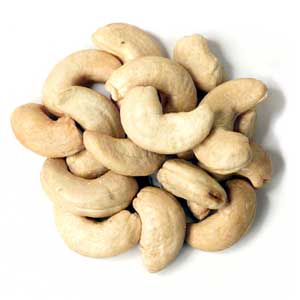Often associated with Southern India – Goa, Kerala and Sri Lanka, the cashew actually originated in Brazil.
Portuguese traders in the 16th century brought it to Southern India. Loving local conditions the cashew flourished into huge forests eventually colonizing whole swathes of India, East Africa, the tropical lowlands of South America, Central America and the West Indies. These fast growing evergreen trees reach up to 12 meters high and their lush canopies can cover huge areas. The largest in the world covers about 7,500 square metres or 81,000 square feet!
The little Cashew nut is an oddity from the outset. For a start it’s actually a seed which grows from the base of a pear-shaped fruit, known as the ‘cashew apple’ – which isn’t a real fruit. The actual fruit is the kidney shaped ‘drupe’ within which the seed develops, surrounded by several toxic layers which cause a nasty skin rash on contact. This toxic resin, anacardic acid, is chemically related to the better-known poison ivy. In order to make the green cashew seed edible it has to be roasted to neutralize the acid. During this process even the smoke is toxic, but the seeds turn the warm beige colour we are familiar with.
The export of 40-50,000 tonnes of cashews earns India over 200 million dollars a year; and there are over 200 registered patents for the commercial use of the shell oil. Surprisingly it’s used in the manufacture of products like clutch plates, brake linings and isolators, varnish, paints and plastics.
The toxic oil is also used as an anti-termite treatment, in the treatment of cracked heels and tooth decay! Its medicinal properties are now being developed for drugs, antioxidants and fungicides. In Guyana the bark is prepared as an anti-diarrheal, and the seeds are ground up into powders used as an antidote for snake bites.
During World War II the covert Special Operations Executive used the corrosive oil to destroy the crankcases of German vehicles!
Nutritionally the Cashew kernel contains 21% vegetable protein and a high concentration of amino acids, antioxidants, copper, iron and zinc. The conical, red or yellow, cashew ‘apples’ contain five times more vitamin C than an orange plus more calcium, iron and vitamin B1 than citrus fruit, avocados or bananas.
They have a strong “sweet” smell and taste and the pulp is often made into syrup, juices, jams and jellies. A refreshing tropical fruit drink made in Latin America has been described as tasting like mango, grapefruit and a little hint of green capsicum.
Cashews, unlike other oily tree nuts, contain starch making them an effective thickener for soups, stews or desserts. Many Asian cuisines use them for this unusual characteristic. In India, powdered it is used in the production of several sweets, and ground cashew paste is the base for curries such as Korma.
In both savoury and sweet form the versatile cashew appears in the cuisines of Thailand, China, the Philippines, Indonesia, Mozambique, Nigeria, Panama, Brazil and other South American countries. And across the world a strong liqueur is distilled from the cashew. The Dutch considered the West Indies version superior to brandy. In Tanzania it’s called Gongo, and in Mozambique it is known as ‘Agua Ardente’ – burning water!
Feni,or Fenny, the Indian cashew liqueur, is about 40% proof and cannot be sold outside the state of Goa. But If you ever have the chance to try it – do. Not for the faint of heart it is full of cashew flavour and very enjoyable on the rocks or with a slice of lime!







